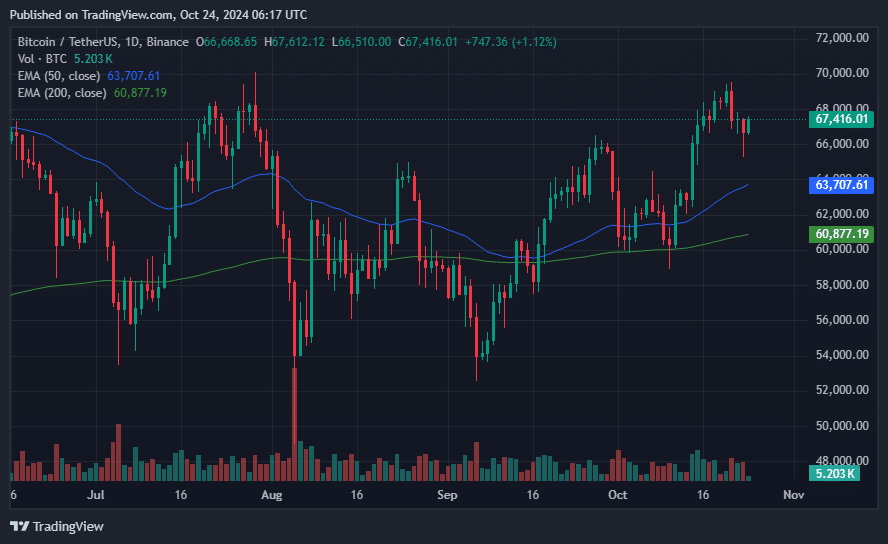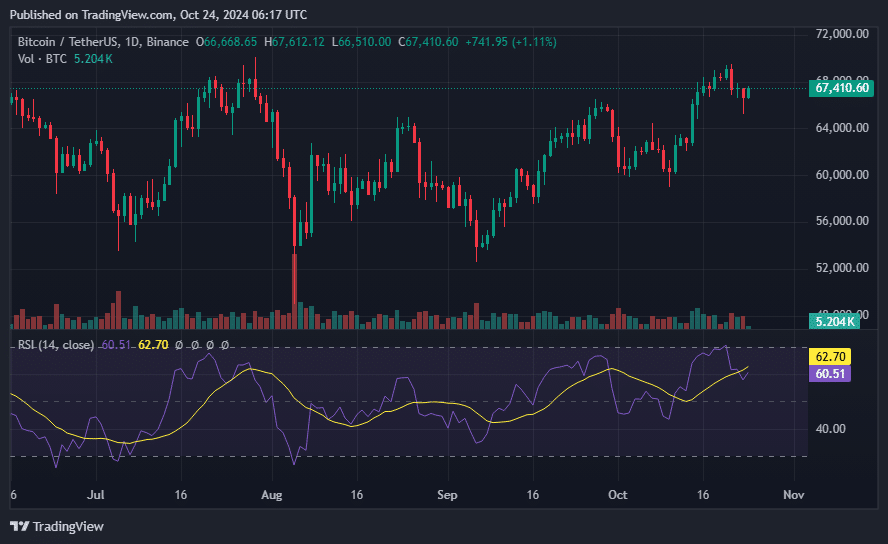On October 23, BlackRock’s IBIT saw a surge of $317 million in inflows as investors reacted to Bitcoin’s decline of over 3%, with the cryptocurrency testing a crucial support level at $65,000.
On the same day, Bitcoin experienced notable downward movement, dipping by 3.3% to finish at $66,649, a stark contrast to the 0.12% gains seen in the prior session. While testing the demand from buyers at $65,000, BTC reached a session low of $65,161 before rebounding above the $66,000 mark.
The overall cryptocurrency market reflected this downturn, losing 1.45% and reaching a total market capitalization of $2.242 trillion.
This decline is linked to shifting market sentiment, fueled by concerns surrounding the forthcoming US Presidential Election and the Federal Reserve’s interest rate outlook.
Risk assets, including Bitcoin, faced selling pressure as investors became increasingly cautious about tightening monetary policy. Meanwhile, the Nasdaq Composite Index dropped by 1.60% as the 10-year US Treasury yields climbed to 4.26%, the highest since July, indicating strength in the US economy and challenging expectations for multiple Fed rate cuts in Q4 2024.
US presidential election and market impact
As the US Presidential Election draws closer, uncertainty continues to strain investor sentiment. Recent polls show Vice President Kamala Harris leading former President Donald Trump by a slim 1.7-point margin, although Trump has narrowed the gap considerably from a previous 3.7-point deficit.
Despite Harris leading, betting platform Polymarket indicates Trump has a higher chance of winning, with a 59.7% probability compared to Harris’ 40.4%.
A potential Trump presidency is anticipated to create inflationary pressures, which might prompt a more hawkish stance from the Federal Reserve. While this could suppress demand for riskier assets like Bitcoin, Trump’s cryptocurrency-friendly policies may enhance long-term demand for the digital asset.
Spot Bitcoin ETFs drive recovery
In spite of macroeconomic uncertainties, Bitcoin showed resilience by bouncing back from the $65,000 support level, driven by renewed inflows into spot Bitcoin ETFs, particularly BlackRock’s IBIT. This surge came after a day of outflows that saw $79.1 million leave the fund due to investor concerns over the sustainability of Bitcoin’s rally.
On October 23, the 12 spot Bitcoin ETFs recorded net inflows of $192.31 million, with BlackRock’s IBIT contributing the majority at $317.47 million. This marked the fourth instance in six trading days that the fund garnered over $300 million in inflows, bringing its total net inflows to over $23 billion as of October 21.
Grayscale’s Bitcoin Minit Trust also played a role in the positive sentiment, recording inflows of $4.71 million, while other ETF products such as ARKB, BITB, and VanEck experienced combined outflows of $129.8 million, indicating a more cautious perspective among certain market participants.
Technical outlook for Bitcoin
Despite the price drop on Wednesday, Bitcoin remains above critical technical levels, including the 50-day and 200-day exponential moving averages, solidifying bullish signals.

A breakout above the $69,000 resistance level and the October 21 high of $69,402 could set the stage for a movement towards the psychological $70,000 threshold. If Bitcoin successfully breaks through $70,000, bulls might attempt to tackle the previous all-time high of $73,808.
Conversely, a drop below $66,500 could reignite bearish momentum, re-focusing attention on the crucial $65,000 support level. Should Bitcoin decline further below $65,000, it may pave the way for a more substantial correction, targeting $64,000 as the next significant support level.

With a reading of 60 on the 14-day Relative Strength Index, Bitcoin holds potential to reach $70,000 before entering overbought territory.
At the time of writing, Bitcoin (BTC) was observed to be up 0.5%, trading at $67,345.








